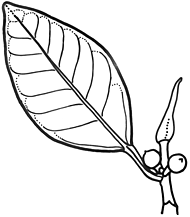Common name: Small-leaved Fig
Ficus obliqua G.Forst. APNI* Synonyms: Ficus virginea Banks & Sol. ex Hiern APNI*

Description: Medium-sized to large strangling tree with massive trunks of coalesced roots, buttressed; young stems glabrous.
Leaves elliptic to oblong-lanceolate, 3–13 cm long, 1.5–6 cm wide, moderately thick, glabrous; venation visible on both surfaces, but raised and more prominent below, secondary veins 8–12 pairs, looping to form an intramarginal vein, reticulum distinct; petiole usually 1–1.5 cm long; stipules usually 1–2.5 cm long, glabrous.
Figs ± globose, mostly 6–10 mm diam., turning orange with dark red spots; stalk usually 1–4 mm long; paired; ripe Apr.–June.
Distribution and occurrence: Chiefly in coastal areas and adjacent ranges west to the Liverpool Ra., mainly in subtropical and littoral rainforest; north from Mt Dromedary.
NSW subdivisions: NC, CC, SC, NT, ST, CWS
Other Australian states: Qld
Varieties are recognized. All material examined for N.S.W. is var. obliqua. However, var. petiolaris (Benth.) Corner has been reported for N.S.W. It differs in having larger fruits (10–15 mm diam.), on stalks 2.5–10 mm long and petioles to 4 cm long.
Text by G. J. Harden
Taxon concept:
Taxa not yet included in identification key
Ficus obliqua var. obliqua
APNI* Provides a link to the Australian Plant Name Index (hosted by the Australian National Botanic Gardens) for comprehensive bibliographic data
***The AVH map option provides a detailed interactive Australia wide distribution map drawn from collections held by all major Australian herbaria participating in the Australian Virtual Herbarium project.
|


